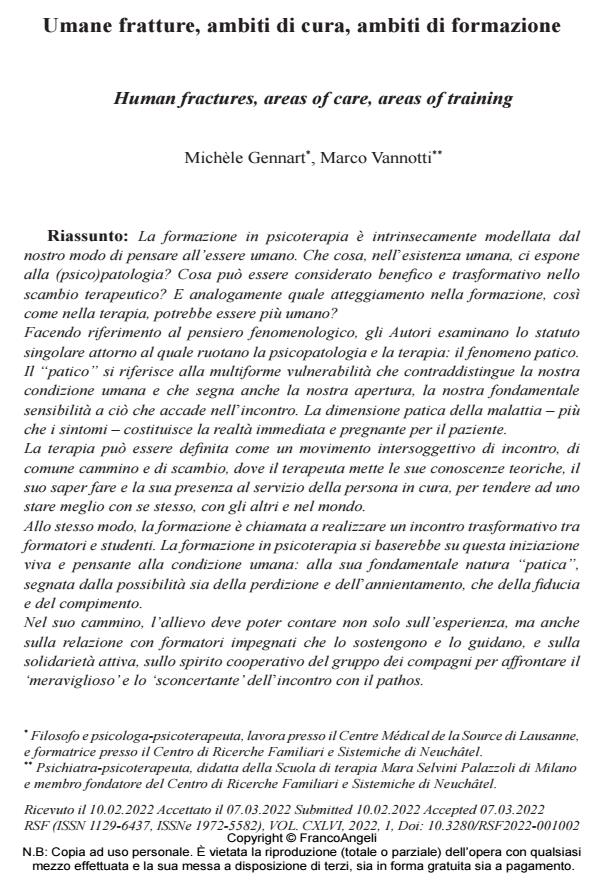Human fractures, areas of care, areas of training
Journal title RIVISTA SPERIMENTALE DI FRENIATRIA
Author/s Michèle Gennart, Marco Vannotti
Publishing Year 2022 Issue 2022/1
Language Italian Pages 34 P. 13-46 File size 240 KB
DOI 10.3280/RSF2022-001002
DOI is like a bar code for intellectual property: to have more infomation
click here
Below, you can see the article first page
If you want to buy this article in PDF format, you can do it, following the instructions to buy download credits

FrancoAngeli is member of Publishers International Linking Association, Inc (PILA), a not-for-profit association which run the CrossRef service enabling links to and from online scholarly content.
Psychotherapy training is intrinsically shaped by the way we think about the human being. What, in human existence, exposes us to (psycho)pathology? What can be considered beneficial and transformative in the therapeutic exchange? And similarly, what approach in training, as well as in therapy, could be more humane? Referring to phenomenological thought, the authors examine the singular statute around which psychotherapy and therapy revolve: the pathic phenomenon. "Pathic" refers to the multiform vulnerability that characterizes our human condition and that also marks our openness, our fundamental sensitivity to what happens in the encounter. The pathic dimension of the illness - more than the symptoms - constitutes the immediate and meaningful reality for the patient. Therapy can be defined as an intersubjective process of encounter, of common path and exchange, where the therapist places his or her theoretical knowledge, know-how, and presence at the service of the person under treatment in order to strive for a better way of being with self, with others and in the world. In the same way, training is called upon to achieve a transformative encounter between trainers and students. Training in psychotherapy should be based on this living and thinking initiation to the human condition, to its fundamental "pathic" nature, marked by the possibility of perdition and annihilation as well as trust and fulfilment. In their journey, the students must be able to rely not only on experience but also on the relationship with committed instructors who support and guide them, and on the active solidarity and cooperative spirit of the group of companions to face both the ‘wonderful’ and the ‘disconcerting’ in the encounter with pathos.
Keywords: training, psychotherapy, psychopathology, pathic experience, vulnerability.
- Das systemisch-familiär-individuelle Modell (SFI) Liliana Redaelli, Luca Codecá, Matteo Selvini, in Familiendynamik /2026 pp.32
DOI: 10.21706/fd-51-1-32
Michèle Gennart, Marco Vannotti, Umane fratture, ambiti di cura, ambiti di formazione in "RIVISTA SPERIMENTALE DI FRENIATRIA" 1/2022, pp 13-46, DOI: 10.3280/RSF2022-001002